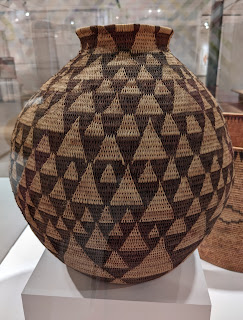Huge "Hopi baskets" splashed throughout the homes of millions of television viewers on January 1, 2024. Along with colorful butterflies and cacti, the baskets made their way down Colorado Boulevard on a float in the Rose Parade, Pasadena's 135th celebration of community and flowers. This float's crowning achievement is the Hopi woman figure, resplendent in her face paint, turquoise jewelry, and tableta headdress. Typically a wooden-framed structure decorated with paint and feathers, this tableta was made of "cranberry seed, dehydrated red pepper, carrots and black beans," with details in white everlasting flowers and purple, yellow and blue statice. (Source: Pasadena's Rose Magazine, Southern California News Group, 2024.)
She is magnificent. This float won the Rose Parade's Judges Award for most outstanding float design and dramatic impact.

The float, titled Woven Together: The Dance of Life, is from OneLegacy Donate Life. It commemorates donors of eyes, organs, and tissues by recreating their portrait images in floragraphs. The multi-colored floragraphs, made of flowers and other plant parts, are each about 12" x 16" in size. https://www.onelegacy.org/
(Parade photos taken from the tv screen by Bryn Potter 1-1-24.)
Together with the organ donors, the float celebrates the Hopi people. According to the tribal website, "the Hopi Tribe is a sovereign nation located in northeastern Arizona. The reservation occupies part of Coconino and Navajo counties, encompasses more than 1.5 million acres, and is made up of 12 villages on three mesas." https://www.hopi-nsn.gov/On the Hopi Reservation, the villages on the three mesas are active communities today, yet they date to ancient times. Second Mesa is the home of coiled basketry. Coiled baskets are the type that are recreated on the parade float. In 2005, I curated the exhibit Hopi: People of the Mesas at the Museum of Riverside. Here is the brief label text I wrote on Hopi coiled basketry:
"Baskets
have many functions in traditional Hopi life. In addition to their use
in food preparation and serving, baskets often have ceremonial roles. Some are made for ritual use, they can be part of traditional gift
exchanges and weddings, and they are carried in basket dances
performed by women's societies. Today, the Hopi people still weave
and use baskets.
 |
Detail, Hopi coiled basket.
Photo: Bryn Potter.
|
The baskets by the Hopi at Second Mesa are made using the coiled
technique. Split yucca leaf is sewn around a central foundation made
of a bundle of gallenta grass. This type of basket looks like a
thick coil spiraling outward from the center."
The yucca leaf appears in its natural yellowish color and forms the background for the baskets in these photos.The yucca leaf can also be dyed to create the vibrant red, black, and other colors seen here.
Hopi Basket Weaving: Artistry in Natural Fibers by Helga Teiwes, 1996, the University of Arizona Press, is a wonderful source book for those seeking more information on Hopi basketry.
 |
Hopi olla, circa 1920-1940, National Museum of
the American Indian, Smithsonian, catalog #26/1890.
|
Back to the float. The coil can be seen as the horizontal lines on the baskets. The float's bowl, tray, and olla (jar) shapes convey the appearance of baskets, at least as seen from my tv screen, from which I snapped the Rose Parade photos above. The designs are typical of many Hopi baskets, and inclusion of the floragraphs are innovative, both touching and very personal.
 |
Hopi bowl, circa 1950, National Museum of the
American Indian, Smithsonian, catalog #25/5175 |
I was surprised and pleased to see this amazing float on New Year's Day.
May it bode well that 2024 be another fine year for basketry.
 Specifically, there is one very well designed and functional exhibit case which tells a story that I've been telling for years. The epitome of human and habitat interaction. Basically, "the environment determines the type of plants that grow in a region. Basketweavers have an intimate awareness of their environment. They know which plants they need and when, where, and how they should be gathered and prepared." The materials, whether they be slender fern fronds, strong roots, or stout willow branches, help to govern the techniques used in local basketry, and the types of baskets that are woven. (Source: Reflections of Culture: Basketry from the Southwest Museum by Bryn Barabas Potter, 2000, Southwest Museum, Los Angeles CA.)
Specifically, there is one very well designed and functional exhibit case which tells a story that I've been telling for years. The epitome of human and habitat interaction. Basically, "the environment determines the type of plants that grow in a region. Basketweavers have an intimate awareness of their environment. They know which plants they need and when, where, and how they should be gathered and prepared." The materials, whether they be slender fern fronds, strong roots, or stout willow branches, help to govern the techniques used in local basketry, and the types of baskets that are woven. (Source: Reflections of Culture: Basketry from the Southwest Museum by Bryn Barabas Potter, 2000, Southwest Museum, Los Angeles CA.) The basket is on top, with text labels,and a bunch of juncus. The case has a few pull-out drawers which share more information about the region's basketry, including finely preserved herbarium specimens.
The basket is on top, with text labels,and a bunch of juncus. The case has a few pull-out drawers which share more information about the region's basketry, including finely preserved herbarium specimens.













